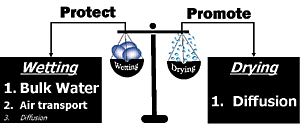Air Barriers: Increasing Building Performance, Decreasing Energy Costs
Structural integrity is another attribute of an effective air barrier. Air barriers must be able to withstand pressure loads or be able to transfer the load to other elements of the building envelope without rupture or displacement. For mechanically fastened building wraps, the type of mechanical fasteners and their spacing are important for structural integrity, and the installation must be done according to the manufacturer's instructions.
Finally, air barriers must be durable. They must be able to withstand environmental exposure, including exposure to ultraviolet (UV) rays, thermal cycles, and mechanical pressure. These requirements extend from the construction cycle through the service life of the enclosure. If that life-cycle requirement can't be met, then an air barrier must be accessible for periodic maintenance.
In addition to these basic requirements, an air barrier membrane should also balance the critical barrier properties for optimum moisture management: air infiltration resistance, water resistance, and vapor permeability. The air barrier membrane should combine high resistance to water penetration and air infiltration (to protect against bulk water intrusion and moisture transported by air currents, respectively), with optimum moisture vapor permeability to allow drying from incidental moisture. The balance of properties is generally difficult to achieve, because the three barrier properties have competing demands. Consequently, only few materials achieve this optimum balance, while most excel in one or two categories.
|
The multiple consequences of uncontrolled airflow may result in potential liability issues for the entire building community. Architects, consultants, and engineers could be held liable for moisture damage in buildings because of faulty design or poor material selection. Contractors' workmanship can be called into question when water damage is due to poor execution of the intended design or unauthorized material substitution. Building owners may be held responsible for poor indoor air quality, mold problems or lack of thermal comfort. With serious consequences for the design and building industry professionals, building owners and building users, it behooves all members of the building team to pay close attention to controlling unwanted air flow and selecting the proper barrier method.
SELECTING APPROPRIATE AIR BARRIERS
There are many types of commercial air barrier membranes. Based on the method of application, there are three main types of air barriers: mechanically fastened (building wraps); peel-and-stick or self-adhered; and fluid applied. Based on vapor permeability, air barrier materials are vapor permeable and vapor non-permeable. Mechanically fastened membranes are vapor permeable; some fluid applied membranes have limited vapor permeability; all others are vapor non-permeable. While the application method is often a personal preference, the vapor permeability of air barrier membranes has performance implications, which must be considered when selecting an air barrier. As a general rule, vapor permeable air barriers can and should be used in all climates, while vapor non-permeable air barriers (air and vapor barriers) are climate specific.
|
||||











